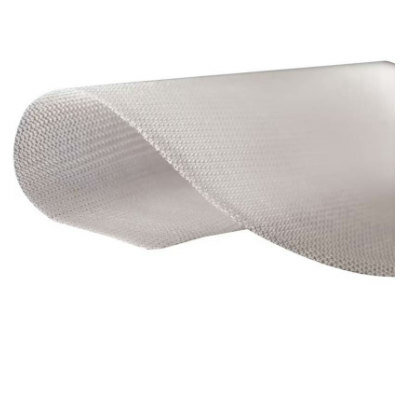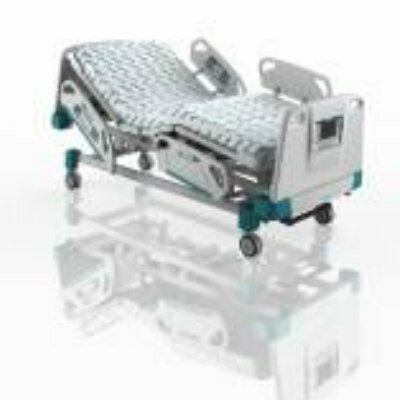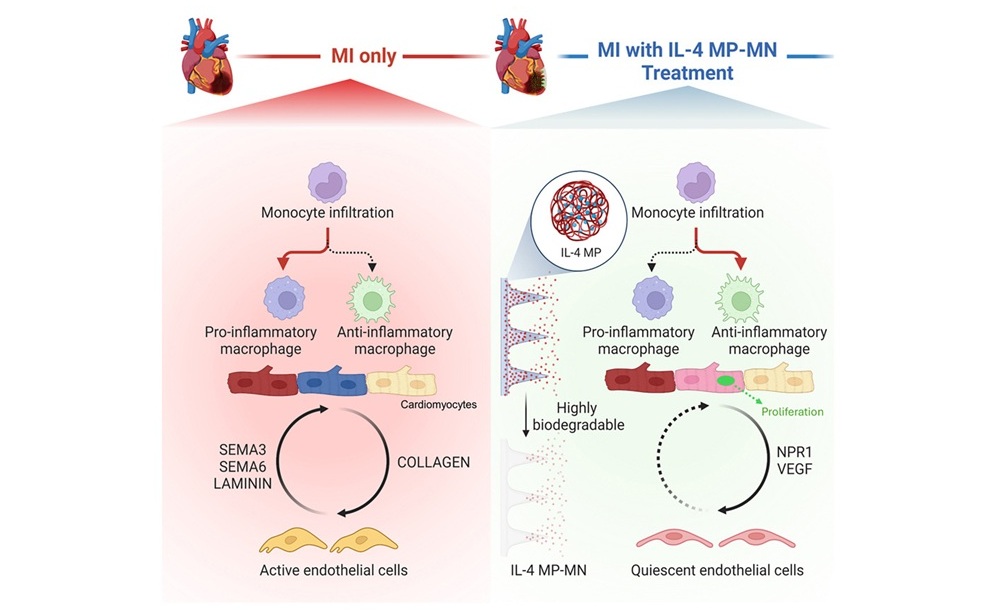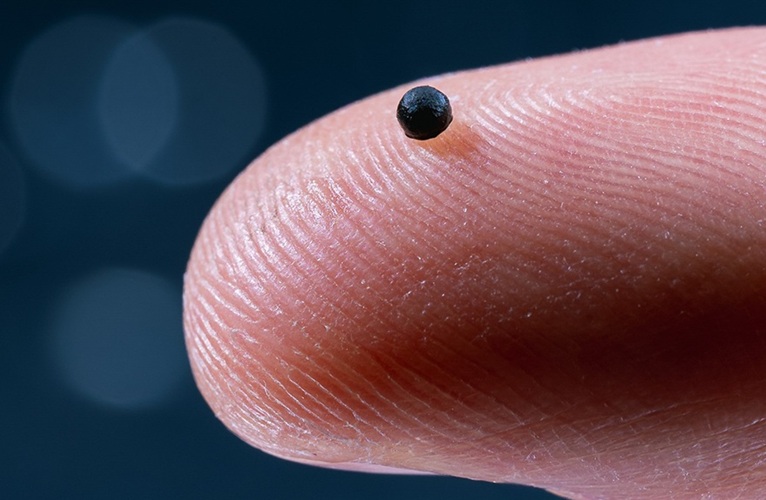Closure System Permanently Seals Varicose Veins 
|
By HospiMedica International staff writers Posted on 01 Mar 2015 |
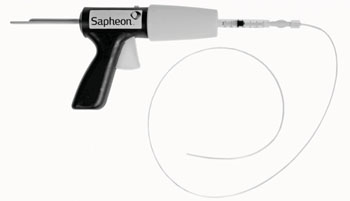
Image: The VenaSeal Closure System (Photo courtesy of Sapheon).
A novel embolic system uses an adhesive agent that polymerizes inside superficial varicose veins of the legs, sealing them shut.
The VenaSeal Closure System is composed of a specially formulated adhesive (n-butyl-2-cyanoacrylate) and a delivery system that includes a catheter, guidewire, dispenser gun, dispenser tips, and syringes. The VenaSeal Closure System does not require tumescent anesthesia to be injected peripherally into the leg, and because there are no pre-procedures drugs involved, patients can usually return to their normal activities right after the treatment, with just a Band-Aid in place.
For example, to seal the great saphenous vein (GSV), the catheter is first guided via ultrasound (US) towards the saphenofemoral junction (SFJ); once properly placed near the SFJ, the adhesive is injected into the lumen, sealing the vein. The procedure is then repeated every three cm along the GSV. Once closed, blood is immediately rerouted through other healthy veins in the leg. The VenaSeal Closure system is a product of Sapheon (Morrisville, NC, USA), a part of Covidien (Dublin, Ireland), and has been approved by the US Food and Drug Administration (FDA).
“Cyanoacrylate embolization is an effective and durable solution to the problem of incompetent great saphenous veins; long-term effectiveness is high,” said Prof. Thomas Proebstle, MD, of Mainz University (Germany), who led the European multicenter clinical study of the system. “The elimination of the need for perivenous tumescent anesthesia and post-interventional compression stockings, along with the associated side effects, results in significantly improved treatment.”
“This new system is the first to permanently treat varicose veins by sealing them with an adhesive, thereby giving patients another treatment option for this common condition,” said William Maisel, MD, MPH, acting director of the office of device evaluation in the FDA’s Center for Devices and Radiological Health (CDRH). “Because the VenaSeal system does not incorporate heat application or cutting, the in-office procedure can allow patients to quickly return to their normal activities, with less bruising.”
Varicose veins (also known as venous reflux disease) occur when valves inside the veins break and blood is unable to circulate properly. This is a common condition that affects both men (25%) and women (40%). Varicose veins can occur anywhere from the groin to the ankle.
Related Links:
Sapheon
Covidien
The VenaSeal Closure System is composed of a specially formulated adhesive (n-butyl-2-cyanoacrylate) and a delivery system that includes a catheter, guidewire, dispenser gun, dispenser tips, and syringes. The VenaSeal Closure System does not require tumescent anesthesia to be injected peripherally into the leg, and because there are no pre-procedures drugs involved, patients can usually return to their normal activities right after the treatment, with just a Band-Aid in place.
For example, to seal the great saphenous vein (GSV), the catheter is first guided via ultrasound (US) towards the saphenofemoral junction (SFJ); once properly placed near the SFJ, the adhesive is injected into the lumen, sealing the vein. The procedure is then repeated every three cm along the GSV. Once closed, blood is immediately rerouted through other healthy veins in the leg. The VenaSeal Closure system is a product of Sapheon (Morrisville, NC, USA), a part of Covidien (Dublin, Ireland), and has been approved by the US Food and Drug Administration (FDA).
“Cyanoacrylate embolization is an effective and durable solution to the problem of incompetent great saphenous veins; long-term effectiveness is high,” said Prof. Thomas Proebstle, MD, of Mainz University (Germany), who led the European multicenter clinical study of the system. “The elimination of the need for perivenous tumescent anesthesia and post-interventional compression stockings, along with the associated side effects, results in significantly improved treatment.”
“This new system is the first to permanently treat varicose veins by sealing them with an adhesive, thereby giving patients another treatment option for this common condition,” said William Maisel, MD, MPH, acting director of the office of device evaluation in the FDA’s Center for Devices and Radiological Health (CDRH). “Because the VenaSeal system does not incorporate heat application or cutting, the in-office procedure can allow patients to quickly return to their normal activities, with less bruising.”
Varicose veins (also known as venous reflux disease) occur when valves inside the veins break and blood is unable to circulate properly. This is a common condition that affects both men (25%) and women (40%). Varicose veins can occur anywhere from the groin to the ankle.
Related Links:
Sapheon
Covidien
Latest Surgical Techniques News
- Novel Endoscopy Technique Provides Access to Deep Lung Tumors
- New Study Findings Could Halve Number of Stent Procedures
- Breakthrough Surgical Device Redefines Hip Arthroscopy
- Automated System Enables Real-Time "Molecular Pathology" During Cancer Surgery
- Groundbreaking Procedure Combines New Treatments for Liver Tumors
- Ablation Reduces Stroke Risk Associated with Atrial Fibrillation
- Optical Tracking Method Identifies Target Areas in Robot-Assisted Neurosurgery
- General Anesthesia Improves Post-Surgery Outcomes for Acute Stroke Patients
- Drug-Coated Balloons Can Replace Stents Even in Larger Coronary Arteries
- Magnetic Kidney Stone Retrieval Device Outperforms Ureteroscopic Laser Lithotripsy
- Absorbable Skull Device Could Replace Traditional Metal Implants Used After Brain Surgery
- Magic Silicone Liquid Powered Robots Perform MIS in Narrow Cavities
- 'Lab-on-a-Scalpel' Provides Real-Time Surgical Insights for POC Diagnostics in OR
- Biodegradable Brain Implant Prevents Glioblastoma Recurrence
- Tiny 3D Printer Reconstructs Tissues During Vocal Cord Surgery
- Minimally Invasive Procedure for Aortic Valve Disease Has Similar Outcomes as Surgery
Channels
Critical Care
view channel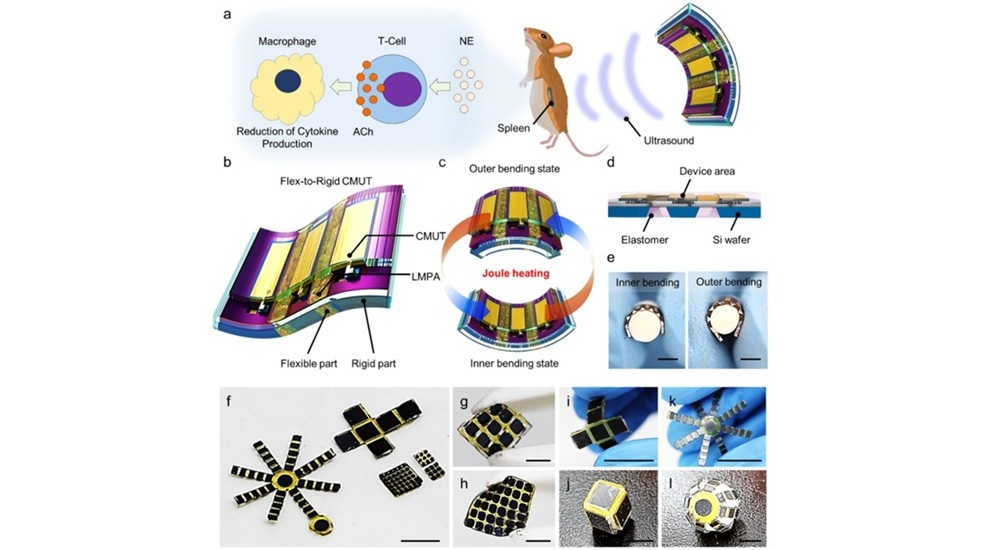
Wearable Ultrasound Sensor Delivers Noninvasive Treatment Without Surgery
Wearable ultrasound devices have long struggled with low acoustic power and poor structural stability, limiting their use in high-resolution imaging and therapeutic applications. Conventional flexible... Read more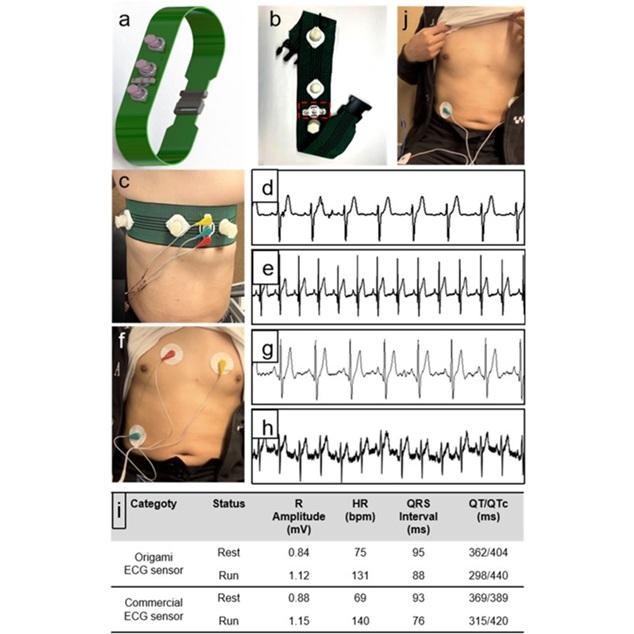
Gel-Free ECG System to Transform Heart Health Diagnosis
Electrocardiogram monitoring is essential for detecting heart rhythm disorders, yet current systems rely on disposable gel-based electrodes that can dry out, fall off, and generate significant medical waste.... Read morePatient Care
view channel
Revolutionary Automatic IV-Line Flushing Device to Enhance Infusion Care
More than 80% of in-hospital patients receive intravenous (IV) therapy. Every dose of IV medicine delivered in a small volume (<250 mL) infusion bag should be followed by subsequent flushing to ensure... Read more
VR Training Tool Combats Contamination of Portable Medical Equipment
Healthcare-associated infections (HAIs) impact one in every 31 patients, cause nearly 100,000 deaths each year, and cost USD 28.4 billion in direct medical expenses. Notably, up to 75% of these infections... Read more
Portable Biosensor Platform to Reduce Hospital-Acquired Infections
Approximately 4 million patients in the European Union acquire healthcare-associated infections (HAIs) or nosocomial infections each year, with around 37,000 deaths directly resulting from these infections,... Read moreFirst-Of-Its-Kind Portable Germicidal Light Technology Disinfects High-Touch Clinical Surfaces in Seconds
Reducing healthcare-acquired infections (HAIs) remains a pressing issue within global healthcare systems. In the United States alone, 1.7 million patients contract HAIs annually, leading to approximately... Read moreHealth IT
view channel
EMR-Based Tool Predicts Graft Failure After Kidney Transplant
Kidney transplantation offers patients with end-stage kidney disease longer survival and better quality of life than dialysis, yet graft failure remains a major challenge. Although a successful transplant... Read more
Printable Molecule-Selective Nanoparticles Enable Mass Production of Wearable Biosensors
The future of medicine is likely to focus on the personalization of healthcare—understanding exactly what an individual requires and delivering the appropriate combination of nutrients, metabolites, and... Read moreBusiness
view channel
Philips and Masimo Partner to Advance Patient Monitoring Measurement Technologies
Royal Philips (Amsterdam, Netherlands) and Masimo (Irvine, California, USA) have renewed their multi-year strategic collaboration, combining Philips’ expertise in patient monitoring with Masimo’s noninvasive... Read more
B. Braun Acquires Digital Microsurgery Company True Digital Surgery
The high-end microsurgery market in neurosurgery, spine, and ENT is undergoing a significant transformation. Traditional analog microscopes are giving way to digital exoscopes, which provide improved visualization,... Read more
CMEF 2025 to Promote Holistic and High-Quality Development of Medical and Health Industry
The 92nd China International Medical Equipment Fair (CMEF 2025) Autumn Exhibition is scheduled to be held from September 26 to 29 at the China Import and Export Fair Complex (Canton Fair Complex) in Guangzhou.... Read more







